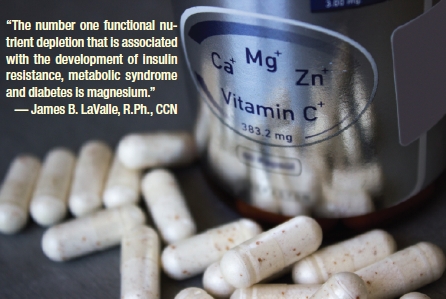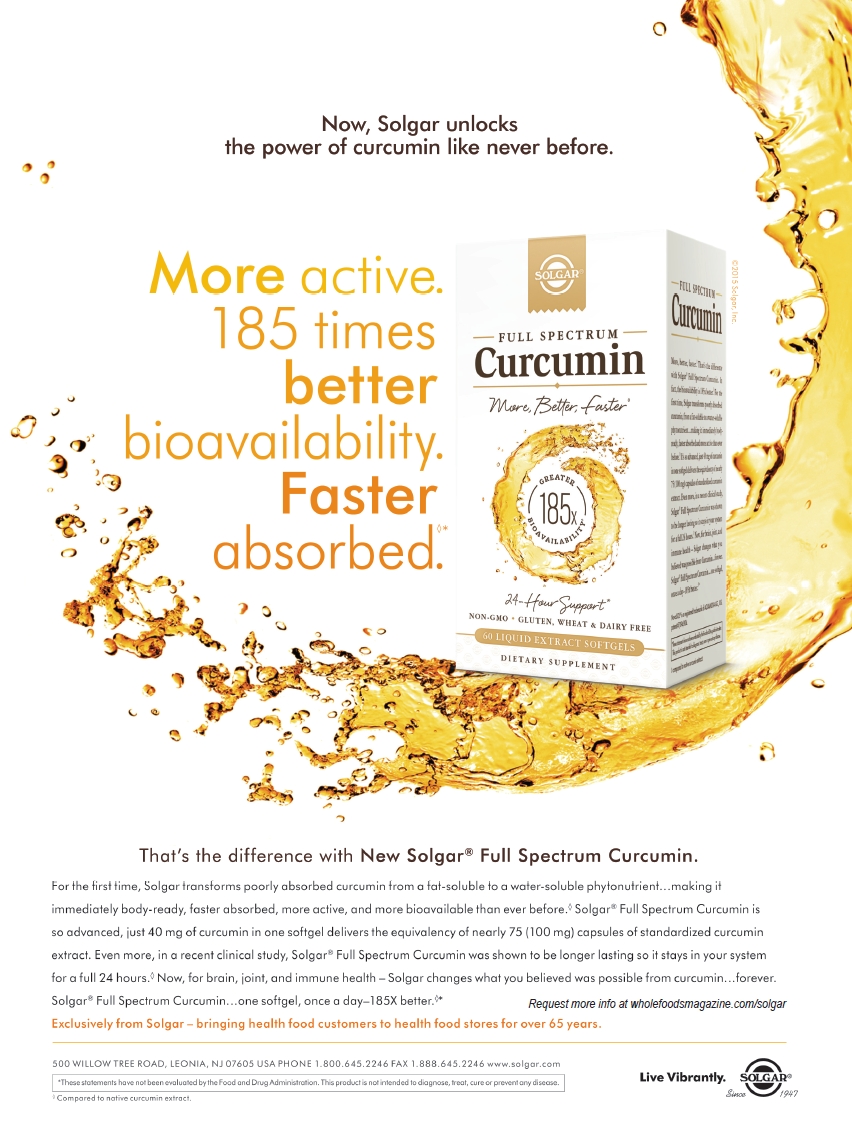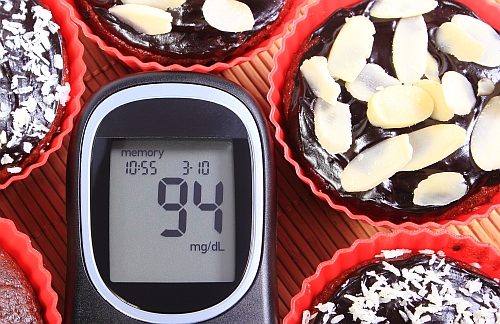Our bodies use nutrients from food to fuel many everyday functions—this fact is well-known. However, this relationship means that when food is converted improperly, all of these functions are at risk. One way that this relationship plays out is blood sugar imbalance.
The first thing people may associate with blood sugar imbalance is diabetes, and it’s not hard to see why. According to data from the 2014 National Diabetes Statistics Report, approximately 29.1 million Americans have diabetes, and it was the seventh leading cause of death in 2010 (1). At the same time, though, blood sugar imbalance can lead to a variety of health issues outside diabetes, so it is important to keep your customers as informed as possible on both how blood sugar imbalance impacts the body and the supplemental options available to combat it.
Getting the Right Fuel
To understand the nature of blood sugar imbalance and its effects, it’s important to revisit its proper function. Jay Levy, director of sales at Wakunaga of America Co., Ltd., Mission Viejo, CA, explains that when carbohydrates are broken down during digestion, they become a simple sugar known as glucose. “The pancreas produces a hormone known as insulin, which helps the cells absorb and utilize glucose,” he adds. Normally, this provides us with the necessary energy we need for daily activities, but disruption of this process leads to many potentially harmful conditions, diabetes included. “Diabetes occurs when high levels of blood sugar are present in the body either because of the inability of the body to produce enough insulin or the inability to respond to the insulin,” explains Shaheen Majeed, marketing director of Sabinsa Corp., East Windsor, NJ.
Type 1 diabetes, the less common type, occurs when the pancreas is unable to generate insulin  properly, leading to injected insulin being required. Generally, most type 1 diabetes cases occur in children. Type 2 diabetes occurs when cells become resistant to insulin. Type 2 diabetes is the subject of much attention not just because of its relative frequency, but due to the fact that as the insulin resistance that leads up to it “sets the stage for more serious disease, and is a cause of obesity, hypertension, and coronary heart disease,” says Steve Holtby, president and CEO of Soft Gel Technologies, Inc., Los Angeles, CA.
properly, leading to injected insulin being required. Generally, most type 1 diabetes cases occur in children. Type 2 diabetes occurs when cells become resistant to insulin. Type 2 diabetes is the subject of much attention not just because of its relative frequency, but due to the fact that as the insulin resistance that leads up to it “sets the stage for more serious disease, and is a cause of obesity, hypertension, and coronary heart disease,” says Steve Holtby, president and CEO of Soft Gel Technologies, Inc., Los Angeles, CA.
Michael T. Murray, N.D., director of product science and innovation at Natural Factors Nutritional Products, Inc., Monroe, WA, expands the list of medical conditions linked to insulin resistance even further, including “Alzheimer’s disease, macular degeneration and most forms of cancer.”
Other issues to consider stemming from blood sugar imbalance are prediabetes conditions, which may fly under the radar, but can develop into something very harmful. One example particularly pertinent to the blood sugar discussion is metabolic syndrome, a group of conditions that can sometimes occur together including high blood sugar level, high blood pressure, excess body fat around the waist and abnormal cholesterol level (2). These conditions can easily escalate into a variety of health issues.
Majeed adds that persistent hyperglycemia, a condition caused by heavily rising glucose levels, can lead to increased production of free radicals, particularly reactive oxygen species (ROS). He states, “Increase in the production of ROS causes an imbalance between ROS and cellular defense mechanisms resulting in cell dysfunction and destruction thereby injuring tissues.” So, it is important to realize that as prevalent as diabetes is, it is not the only potential consequence of blood sugar imbalance. Some of its effects also serve as risk factors to conditions like heart disease and non-alcoholic fatty liver disease. The relationship between blood sugar levels and liver health is the subject of much recent research—we’ll dig deeper into some of these facts later on.
So, blood sugar imbalance can lead to many health problems, but how exactly does it reach that point? Michael A. Smith, M.D., senior health scientist and spokesperson at Life Extension, Fort Lauderdale, FL, explains that “following a meal high in simple carbohydrates, blood sugar levels spike. Subsequently, this is followed by insulin spikes.” Refined sugars are some of the most common simple carbohydrates one may get from diet, particularly from processed foods. Consuming meals heavy in sugar consistently for a prolonged period of time leads to repeated insulin spikes, and in time, insulin resistance develops. At this point, high blood sugar levels remain high consistently, which is when most health issues develop.
While high amounts of simple carbohydrate consumption in conjunction with nutritional deficiencies can lead to blood sugar imbalance in anyone, certain demographics have been shown to be particularly at risk. Carolina Burki-Sozzi, director of product development at Horphag Research (exclusive global supplier of Pycnogenol), Geneva, Switzerland, cites information from the American Diabetes Association saying that approximately 25% of Americans over the age of 60 have diabetes. Dallas Clouatre, Ph.D., consultant for R&D at Jarrow Formulas, Inc., Los Angeles, CA, explains that “as we age, our metabolisms slow down and the percentage of lean tissue, which readily accepts blood glucose, declines in favor of more fatty tissue, which is not as good for insulin sensitivity.”
With this said, older individuals are far from the only group susceptible to diabetes and other blood sugar imbalance-related issues. Neil E. Levin, CCN, DANLA, nutrition education manager at NOW Foods, Bloomingdale, IL, points out that “the fact that ‘Adult Onset Diabetes’ was renamed as ‘Type 2 Diabetes’ reflects the reality that this condition has now appeared in younger people, even in children.”
Paul Dijkstra, president and CEO of InterHealth Nutraceuticals, Benicia, CA, says that certain ethnicities have statistically been shown to be at higher risk of diseases stemming from blood sugar imbalance. African Americans, Mexican Americans, American Indians, Native Hawaiians, Pacific Islanders and Asian Americans are some of the groups he mentions.
Holtby also suggests that low levels of affluence and education can indirectly put people at risk to metabolic syndrome due to the type of food they are consuming. “Some clinicians warn that the rising rate of overweight and obesity among youth may herald a tidal wave of metabolic syndrome as they mature into adulthood,” he adds.
 Jocelyn Bérubé, executive and scientific director of health and nutrition at innoVactiv, Inc. says that the dietary and lifestyle issues that can lead to blood sugar imbalance are so widespread that “any person having an excess body weight should be aware that their diabetes risks are increasing,” even though body weight isn’t the only indicator of blood sugar issues.
Jocelyn Bérubé, executive and scientific director of health and nutrition at innoVactiv, Inc. says that the dietary and lifestyle issues that can lead to blood sugar imbalance are so widespread that “any person having an excess body weight should be aware that their diabetes risks are increasing,” even though body weight isn’t the only indicator of blood sugar issues.
Tipping The Scales
With blood sugar imbalance and the conditions that can stem from it increasing to such degrees, it is more important than ever that people are aware of the natural options are available to help regulate blood sugar. Some are familiar and some more uncommon, but due to the wide variety of ways that blood sugar imbalance can impact one’s health, each case may not necessitate the same approach. Levin notes that “glucose management can be helped by adequate (and inhibited by inadequate) nutrient intake,” so keeping proper levels of certain nutrients is a strong place to start. One nutrient that he says has particularly valuable applications is the mineral chromium.
Keeping healthy chromium levels helps improve insulin sensitivity in several ways, according to Holtby, including “increasing the number of insulin receptors; increasing insulin binding; increasing insulin receptor phosphorylation; and by increasing GLUT4 translocation (a specific facilitative glucose transporter that helps shuttle glucose into the cell).”
Aparna Kalidindi, Ph.D., technical sales and marketing manager at Natreon Inc., New Brunswick, NJ, adds that chromium is “involved in carbohydrate, protein and fat metabolism,” in addition to its enhancement of insulin. But, unlike some of the other options available, it is not readily available in food, and when it is, it can generally be difficult to assimilate in the body (3). With this said, while as many as 90% of American diets can be said to be low in chromium, it is rare to be truly deficient. The elderly, pregnant women, people who engage in regular strenuous activity, and people who eat lots of sugary foods are most at risk (4).
As one of the most popular options for blood sugar control, there’s no shortage of studies done regarding chromium. One of the most popular forms of chromium supplements is chromium picolinate, which is bonded with niacin to help ensure maximum absorption. One study took 39 diabetic elderly subjects with an average age of 73, all undergoing rehabilitation following stroke or hip fracture, and supplemented them with 200 micrograms of chromium picolonate twice a day for a three-week period, along with their normal diabetes medication. A separate group of 39 diabetic patients served as a control group, and blood samples, dietary intake and anthropometric data were collected at baseline and at the conclusion of the study. Results showed that in addition to significantly decreased levels of blood glucose, the chromium group also experienced reduced plasma lipid levels (5).
Levy mentions a review of research among type 2 diabetics that “showed chromium picolinate reduced fasting glucose levels up to 15.3% and fasting insulin levels up to 29.8%. In another eight-week study, chromium picolinate helped to control appetite. The women who participated in the study reported less hunger and fewer fatty food cravings than those taking a placebo.” In addition to chromium picolonate, Dijkstra’s company takes chromium formulations in another direction with a chromium complex (ChromeMate) that is oxygen-coordinated and niacin-bound, which he says increases the mineral’s bioavailability. Levin adds that chromium nicotinate (polynicotinate) can be a valuable variation as well.
James B. LaValle, RPh, CCN, says that while chromium’s applications for blood sugar may be well known, “the number one functional nutrient depletion that is associated with the development of insulin  resistance, metabolic syndrome and diabetes is magnesium.” Magnesium deficiency is widespread in many American diets due to a lack of vegetables, he adds, and can lead to a variety of other health problems such as ”muscle aches and spasms, nervousness, increased blood pressure, restless legs, muscle weakness as well as bone loss.” He recommends 3–5 mg/pound bodyweight to replete magnesium levels. Clouatre agrees on the importance of chromium and magnesium as vital minerals for blood sugar control, and adds B vitamins to the mix of nutrients to consider, particularly vitamin B-6 and biotin.
resistance, metabolic syndrome and diabetes is magnesium.” Magnesium deficiency is widespread in many American diets due to a lack of vegetables, he adds, and can lead to a variety of other health problems such as ”muscle aches and spasms, nervousness, increased blood pressure, restless legs, muscle weakness as well as bone loss.” He recommends 3–5 mg/pound bodyweight to replete magnesium levels. Clouatre agrees on the importance of chromium and magnesium as vital minerals for blood sugar control, and adds B vitamins to the mix of nutrients to consider, particularly vitamin B-6 and biotin.
Smith adds water-based cinnamon extract and soluble fibers to the list of “traditional mainstays,” noting that in conjunction with chromium, “this triple-action formula will decrease sugar absorption, improve sugar metabolism and may even improve insulin sensitivity.” Fiber is one particular option that many experts mentioned, with Levin dubbing it “universally recommended as a basic blood sugar control tool” due to its ability to help lower the increases in blood sugar that follow meals. Murray is also a proponent of fiber supplements, but notes that “the effectiveness of any fiber on reducing appetite and supporting healthy blood sugar and cholesterol levels is based directly on the amount of water the fiber is able to absorb and the degree of thickness or viscosity the fiber imparts when in the stomach and intestine.” He recommends a branded unique dietary fiber complex his company offers (PGX) due to the fact that its combination of multiple fibers can achieve higher levels of viscosity and expansion with water than other singular options. Both retailer and consumer alike should keep these properties in mind when looking for fiber supplements.
Another popular choice is alpha-lipolic acid (ALA). According to Holtby, in addition to serving as an antioxidant, ALA is “a cofactor for a number of vital enzymes responsible for metabolism of glucose, and fatty acids to cellular energy.” In addition to its more general usage, more focused scientific research has been done to test its effects on diabetic neuropathy. Diabetic neuropathy occurs when nerves are damaged due to prolonged levels of high blood sugar. Holtby mentions one study where participants showed improvement in symptoms of diabetic neuropathy after taking 600 mg of ALA twice daily over a three-week period (6). Gotu kola has also been shown to improve nerve damage in diabetics in studies, he adds.
In addition to looking to vitamins and minerals, several herbal options can be helpful for both the root causes of blood sugar imbalance as well as some of the conditions that stem from it. Isaac Eliaz, M.D., M.S., Lac., founder and product formulator of ecoNugenics Inc., Santa Rosa, CA, looks to herbs traditionally used in Asian medicine as “an abundant source of powerful herbal remedies that can help address diabetes and metabolic syndrome from many angles.” One option he mentions is fenugreek seeds, which contain high levels of fiber and protein that can help maintain healthy blood sugar levels. Holy basil and berberine, a natural compound derived from botanicals such as golden thread rhizome, Indian Kino bark, goldenseal and Oregon grape, also can support healthy blood sugar levels, he believes.
Levy adds bitter melon to the mix, noting that the fruit has several substances “that encourage the body to use carbohydrates in the way nature intended…This helps maintain healthy blood sugar levels.” He mentions that scientific studies have not only shown bitter melon to be effective as some prescription diabetes drugs, but also to help with insulin sensitivity as well. Clouatre adds that when it comes to bitter melon, preparations matter. “Bitter melon raw and as freshly extracted juice has performed nicely in trials, although dried forms typically have not done as well,” he says, citing a study where a proprietary bitter melon extract performed well in both animal trials and a pilot human clinical (7).
 Sometimes, supplements and certain ingredients normally thought of for one category may prove effective in another one, and blood sugar control is no exception. One example Levy brings up is aged garlic extract (AGE). Traditionally, this supplement is used for cardiovascular support, but some research shows it may have applications for type-2 diabetes sufferers as well. “Taken daily, studies show that AGE can improve the uptake of glucose and help reduce diabetic complications,” he says. Another study regarding diabetics and AGE showed improvement of adiponectin levels in subjects with chronically high blood sugar. Adiponectin is a protein primarily involved in glucose regulation and breaking down fatty acids. Further results from this study showed that the heightened adiponectin levels also helped lower inflammation and increased cellular glucose uptake (8).
Sometimes, supplements and certain ingredients normally thought of for one category may prove effective in another one, and blood sugar control is no exception. One example Levy brings up is aged garlic extract (AGE). Traditionally, this supplement is used for cardiovascular support, but some research shows it may have applications for type-2 diabetes sufferers as well. “Taken daily, studies show that AGE can improve the uptake of glucose and help reduce diabetic complications,” he says. Another study regarding diabetics and AGE showed improvement of adiponectin levels in subjects with chronically high blood sugar. Adiponectin is a protein primarily involved in glucose regulation and breaking down fatty acids. Further results from this study showed that the heightened adiponectin levels also helped lower inflammation and increased cellular glucose uptake (8).
Omega-3 fatty acids, specifically a healthy omega-3 to omega-6 ratio, are another example of a supplement being known for many other health uses applying to blood sugar concerns as well. Holtby cites multiple studies on the effects omega-3 can have on supplementation in those suffering from insulin resistance. In one trial, 50% of participants showed a clinically significant change in insulin-related function after taking docosahexaenoic acid (DHA) over the course of three months (9). Omegas may also help lower risk of further conditions developing in those who are already diabetic. In one study Holtby mentions, diabetic women who regularly consumed fish and long-chain omega-3 fatty acids reduced their risk of heart disease by as much as 64%. Lower risk of total mortality was also noted with higher levels of fish/omega consumption (10).
French maritime pine bark extract is another supplement with other functions that also can support healthy blood sugar levels, says Sébastien Bornet, vice president of global sales and marketing at Horphag Research. Known for its strong antioxidant properties and cardiovascular support properties, pine bark extract (as Pycnogenol) can “help with the normalization of blood sugar levels by slowing the absorption of carbohydrates, which in turn, reduces glucose load to the bloodstream.“ Studies have shown that daily supplementation of the extract can help lower several metabolic syndrome risk factors, including high levels of blood glucose (11).
Maitake mushroom and its extracts have been well known for their versatility, and blood sugar balance is one of many areas where it may be able to play a supporting role. In particular, the SX-fraction (SXF) glycoprotein is believed to help control levels of glucose. In one animal study, 48 diabetic rats were separated into four groups, one taking 2.5 g/kg of SXF daily with their food, one taking gliclazide, one taking pioglitazone and a control group. The study results showed that while all the non-control rats experienced decreased levels of glucose at the end of the study, only the SXF group showed consistent enhanced insulin sensitivity and lowered systolic blood pressure (20). Another study, designed to try and determine the mechanisms behind these properties, reaffirmed said properties further. Results showed that the presence of SXF was able to increase glucose uptake in human skeletal muscle cells with impaired glucose uptake due to high levels, to the point where it exceeded the control group’s uptake. The researchers concluded that SXF may act directly on the insulin transduction signal pathway, overcoming insulin resistance to produce its effects (21).
As research develops and more is learned about blood sugar imbalance and how it can affect the body, there will be some debate over the efficacy of certain supplemental options. One option in the blood sugar control category is Gymnema sylvestre, a small plant native to India. Levin says that gymnema extracts have been used for centuries by Ayurvedic herbalists for the support of glucose metabolism, and his company offers a blood sugar support formulation that contains the extract along with other helpful ingredients like biotin, chromium and ALA. Clouatre acknowledges that gymnema “has a role in formulations,” and says that much of the supplement’s popularity in this category stems from the fact that gymnemic acids can help support insulin release. However, he believes that “many authorities maintain that it is better to improve insulin sensitivity so that less insulin is required…than to only increase insulin release.“ The aforementioned bitter melon is an example he gives as something that increases insulin sensitivity.
Unexpected Consequences
In addition to diabetes and some common symptoms associated with metabolic syndrome, other conditions can stem from blood sugar imbalance, both before and after the onset of diabetes. While there’s no compared to no changes in the control group (13). Bornet says that between this and other studies on the ingredient, Pycnogenol pine bark extract has been confirmed to have positive effects on diabetic retinopathy overall in more than 1,200 patients.
studies on the ingredient, Pycnogenol pine bark extract has been confirmed to have positive effects on diabetic retinopathy overall in more than 1,200 patients.
Smith says that there’s evidence that cataracts may also be tangentially related to blood sugar issues, via the process of glycation. “Glycation is a reaction between glucose and proteins that causes the proteins to become damaged and dysfunctional. The result of this interaction is the formation of toxic molecules termed advanced glycation end products, or AGEs.” he explains. In addition to cataracts, AGEs are believed to factor into several other age-related diseases. While all proteins are susceptible to glycation, those in the eye are particularly at risk because they are among the longest-lived proteins in the body. Smith points to carnosine as a potential glycation inhibitor, with it being shown to exhibit protective effects against diabetic nephropathy (i.e., kidney damage associated with diabetes) and reduce the formation of AGEs in scientific study (14).
Eye health issues are not the only potential surprise consequence of blood sugar imbalance. Clouatre says that “Mild liver dysfunction/non-alcoholic fatty liver constitutes an aspect of blood sugar dysregulation that only recently has become recognized as being very common.” Many of the problems that lead into blood sugar imbalance, such as high oxidative stress and high consumption of simple sugars, also lead into liver conditions such as non-alcoholic fatty liver disease (NAFL). This may be a two-way street, though, as Smith explains that “glucose generation from glycogen stored in the liver is often overactive in people with high blood sugar” (15). His supplement of choice to combat this issue is chlorogenic acid, the active ingredient in green coffee bean extract. Studies have shown that chlorogenic acid can inhibit the production of glucose-6-phosphatase enzyme in a dose-dependent manner, resulting in reduced glucose production overall for those with high levels (16). Because of the relationship between the liver and blood sugar levels, sometimes “herbs used for liver support may improve blood sugar regulation, a hypothesis borne out in practice,” Clouatre explains. He cites a study where diabetics took 200 mg of silymarin, extracted from milk thistle seeds, three times a day along with their typical medication. In addition to significantly improved fasting blood glucose control, the silymarin group also saw decreasing levels of total cholesterol, LDL cholesterol, triglyceride and liver enzymes (17).
Kalidindi calls attention to the legs and feet as other areas where problems may occur. “Prolonged blood sugar imbalances (elevated blood sugar) can result in poor circulation due to hardening of the arteries in the legs and feet,” she explains. This poor blood flow can lead to increased risk of foot infections and ulcers, and even amputation of feet in extreme circumstances. While the bulk of supplemental solutions for hardened arteries, known as atherosclerosis, generally are concentrated in the cardiovascular health category, some research has been done on potential options for diabetics dealing with this issue specifically. One study checked vitamin D levels in 43 people with type 2 diabetes and 23 other non-diabetic people who were similar in age, sex and weight. Participants with the lowest levels of vitamin D in their blood were more likely to have macrophage cells adhere to the walls of blood vessels, an event that can eventually lead to stiffened vessels and impeded blood flow. While the study results were unable to determine if vitamin D supplementation would be able to reverse the hardening of blood vessels, the study authors noted that vitamin D deficiency was the only common factor in the participants where the cells adhered to the vessel walls (18).
Lightening the Load
From lowering pre-diabetes risk factors to alleviating some of the conditions that spring from full-blown diabetes, supplements can fill a number of vital niches with blood sugar concerns; but ultimately, especially when trying to keep blood sugar levels balanced before health issues arrive, lifestyle choices are a big factor. “Perhaps the greatest contributor to metabolic syndrome, and ultimately type 2-diabetes, is weight. Multiple studies have made the correlation between excess weight and poor sugar metabolism.” says Eliaz.
Dietary choices for blood sugar balance aren’t as simple as counting calories, though—what’s important is to look to low glycemic-foods that ultimately cause minimal spikes and crashes in blood sugar levels after a meal. High fiber vegetables, nuts, whole grains, and legumes are all good foods to incorporate. Kalidindi adds that “carbohydrate counting is critical for diabetes management as carbohydrates are the foods that usually have the greatest impact on blood glucose levels.” She recommends avoiding sugary beverages and processed foods with added sugar whenever possible.
Jon Peters, vice president and general manager at BENEO Inc., Morris Plains, NJ, agrees that low-glycemic diets are an ideal lifestyle change for people looking to manage their blood sugar, citing a meta-analysis of studies showing that the effects of the diet were “comparable to a pharmacological  treatment for lowering postprandial blood glucose responses” over time (19). He also sees sugar replacements and natural carbohydrates in food as a possible way to minimize dietary impact on blood sugar levels, naming sugar beets and chicory root as two examples. When gauging what foods may be a good fit for someone seeking to maintain proper blood sugar balance, Murray recommends looking to the glycemic index, “a numerical scale used to indicate how fast and how high a particular food raises blood glucose (blood sugar) levels.” While he notes refined sugars and white flour products as two potentially harmful items, he adds that the glycemic index only tells half the story. Equally important is monitoring your carbohydrate intake, and a new tool fulfills that purpose: the glycemic load (GL).
treatment for lowering postprandial blood glucose responses” over time (19). He also sees sugar replacements and natural carbohydrates in food as a possible way to minimize dietary impact on blood sugar levels, naming sugar beets and chicory root as two examples. When gauging what foods may be a good fit for someone seeking to maintain proper blood sugar balance, Murray recommends looking to the glycemic index, “a numerical scale used to indicate how fast and how high a particular food raises blood glucose (blood sugar) levels.” While he notes refined sugars and white flour products as two potentially harmful items, he adds that the glycemic index only tells half the story. Equally important is monitoring your carbohydrate intake, and a new tool fulfills that purpose: the glycemic load (GL).
The glycemic load assesses the impact of carbohydrate consumption on the body, already taking the glycemic index into account, “but gives a more complete picture of the effect that a particular food has on blood sugar levels based on how much carbohydrate you actually eat in a serving,” Murray says. He revisits the example of cooked beets as a food that may have a higher glycemic index, but a very low glycemic load, which is part of the reason why it can be an effective natural sweetener while still remaining relatively healthy.
LaValle brings the idea of supplemental help in dealing with high-glycemic load foods. He recommends white bean extract, particularly in those who are having difficulty maintaining a diet low in carbohydrates. He points out one supplemental formation (Phase 2 Carb Controller from Pharmachem Laboratories) in particular that is designed to be taken after meals for this specific purpose. “White bean extract blocks carbohydrate absorption without losing the absorption of other nutrients from food,” he says, adding that the benefits are twofold; “First it lowers the glycemic burden of carbohydrates by about 60%. That means less blood glucose spike after meals, less insulin release and less vascular damage. Secondly, because the starch does not break down, it is delivered to the lower intestine where it feeds the beneficial bacteria.” Healthy gut bacteria can also help support glucose control. Bérubé mentions brown seaweed extract as another supplemental option with a similar function, slowing the release of glucose from dietary carbohydrates after meals.
Another important lifestyle choice to consider for healthy blood sugar balance is regular exercise. In addition to burning calories and increasing metabolism, Levin says exercise “may help to manage blood pressure and waist size, as well as blood sugar; these again are metabolic syndrome risk factors.” Levy says that along with proper dieting and usage of supplements, exercise comprises a “comprehensive 3-pronged strategy” for maintaining blood sugar levels.
Other factors such as managing stress and maintaining regular levels of sleep can also play a role. Majeed says that “The body’s response to metabolic stress depends on the magnitude and duration of the stress. “According to LaValle, the stress hormone cortisol causes blood sugar levels to rise because “it is preparing your body to fight the ‘white tiger.’ The problem is that the white tiger is one too many emails to answer, over-committed schedule and traffic jams.” As a result, these raised glucose levels aren’t properly burned off, as the body anticipates they will be when it releases cortisol. Holtby adds that stress should be “managed in a healthful way that includes deep breathing and/or meditation.” Quality sleep is associated with a variety of health functions, blood sugar balance included. Levy mentions that several studies have showed “that sleep deprivation can have a dramatic effect on blood sugar and insulin levels.” Majeed recommends avoiding sleep during the daytime as well. Sometimes, stress and poor sleep levels can lead to increased cravings and hunger, exacerbating the problem further.
|
Select Blood Sugar Support Products and Ingredients Participating companies were asked to share some of their top-selling products in the blood sugar support category, and here’s what they had to say: BENEO Inc.: Palatinose, ISOMALT, Orafti inulin and Orafti oligofructose. ecoNugenics Inc.: ecoMetabolic. Horphag Research: Pycnogenol. InnoVactiv Inc.: InSea 2. InterHealth Nutraceuticals: ChromeMate. Jarrow Formulas, Inc.: Glucose Optimizer, Citrus Bergamot, Green Coffee Bean Extract, Milk Thistle Extract, R-Alpha Lipoic Acid, Alpha Lipoic Sustain. Life Extension: Tri Sugar Shield, CinSulin with InSea2 and Crominex-3+, CoffeeGenic Green Coffee Extract, Optimized Chromium with Crominex-3+, Natural Glucose Absorption Control, Super R-Lipoic Acid, AMPK Activator, Super Carnosine. Mushroom Wisdom: Sx-Fraction, Super Tremella, Super Royal Agaricus. Natreon Inc.: Crominex-3+, Capros. Natural Factors Nutritional Products, Inc.: PGX Daily Singles. NOW Foods: True Balance, Tri-Chromium, GlucoFit. Pharmachem Laboratories: Phase 2 Carb Controller. Sabinsa Corp.: GS4 PLUS, Silbinol/Pterosin, Momordicin, FenuFibers, Salaretin. Saberry, Fabenol and Fabenol Max. Soft Gel Technologies, Inc.: CoQso, GlucoHelp, CoQH-CF soft gels with Kaneka QH., EZ Mega 3, T-Phenol Polyphenols, GSX-24. Wakunaga of America, Co. Ltd.: Kyolic Blood Sugar Balance, Kyolic Formula 100. |
In some cases, these lifestyle efforts can be intertwined. Clouatre notes that the timing of meals is important as well as the meal content itself. “Consuming most calories at breakfast and lunch has been shown to improve blood sugar regulation. In contrast, consuming calories late in the day, especially within two hours of bedtime, has negative consequences,” he explains. Smith adds that eating something approximately every four hours can help “keep insulin and glucose levels normal.” Mixing exercise and meals together can also work—several experts mention short walks after meals being an effective way to support glucose control after you eat. Together, these lifestyle changes can make an impact, particularly in that borderline group of people who may be experiencing blood sugar imbalance-related issues but haven’t progressed into full-blown diabetes. One example that Levy mentions is the National Institute of Health’s Diabetes Prevention Program.. This clinical trial was designed to find the most effective ways of preventing type-2 diabetes in overweight people with insulin resistance. The results of the program showed that simple lifestyle adjustments like exercise, dietary shift and weight loss reduced diabetes risk in this already at-risk group by 58%.
While it may seem that a lot of effort needs to go into maintenance of blood sugar balance, this shouldn’t come as a huge surprise. Being a facet of health that affects our bodies in so many different ways, maintaining proper blood sugar balance requires effort in many different health areas, from monitoring dietary intake to making healthy lifestyle choices to facilitate proper function as well as proper supplementation to fill necessary nutritional gaps. Along with proper medical advice from a physician, the best thing you can do for your consumers is educate them on supplements and lifestyle choices that can improve their specific situation, as while the end goal of blood sugar balance is the same, different people in different situations may need to approach the question in different ways. WF
References
1. American Diabetes Association. “Statistics about Diabetes.” http://www.diabetes.org/diabetes-basics/statistics/?referrer=https://www.google.com/, accessed 6/17/2015.
2. Mayo Clinic, “Metabolic Syndrome.” http://www.mayoclinic.org/diseases-conditions/metabolic-syndrome/basics/symptoms/con-20027243, accessed 6/18/2015.
3. G.Evans, Chromium Picolinate: Everything You Need to Know. Avery Publishing Group, New York, NY, 1996.
4. University of Maryland Medical Center, “Chromium.” http://umm.edu/health/medical/altmed/supplement/chromium, accessed 6/18/15.
5. Rabinowitz H. et.al. “Effect of chromium supplementation on blood glucose and lipid levels in type 2 diabetes mellitus elderly patients.” Int J Vitam Nutr Res. 74(3), 178-82, 2004.
6. Ziegler, D et al. “Alpha-lipoic acid in the treatment of diabetic polyneuropathy in Germany: current evidence from clinical trials.” Exp Clin Endocrinol Diabetes.;107(7):421-30, 1999.
7. Clouatre DL et.al. ”Bitter melon extracts in diabetic and normal rats favorably influence blood glucose and blood pressure regulation.” J Med Food.;14(12):1496-504, 2011.
8. Gómez-Arbeláez D et.al., “Aged Garlic Extract Improves Adiponectin Levels in Subjects with Metabolic Syndrome: A Double-Blind, Placebo-Controlled, Randomized, Crossover Study.” Mediators of Inflammation, vol. 2013, 2013.
9. Mundell, EJ. “Fish oil compound may help ward off diabetes.” Data presented by Pennington Biomedical Research Institute at the Experimental Biology 2002 conference.
10. Hu, FB. “Fish and long-chain omega-3 fatty acid intake and risk of coronary heart disease and total mortality in diabetic women.” Circulation, 107(14):1852-7, 2003
11. Belcaro G et.al., “Pycnogenol supplementation improves health risk factors in subjects with metabolic syndrome.” Phytother Res., 27(10):1572-8, 2013.
12. National Eye Institiute, “Facts about Diabetic Eye Disease.” https://nei.nih.gov/health/diabetic/retinopathy, accessed 6/19/15.
13. Steigerwalt R et.al. “Pycnogenol improves microcirculation, retinal edema, and visual acuity in early diabetic retinopathy.” J Ocul Pharmacol Ther., 25(6):537-40., 2009
14. Janessen B et.al., “Carnosine as a Protective Factor in Diabetic Nephropathy.” Diabetes, 54(8) 2320-2327, 2005
15. Hemmerle H et.al. “Chlorogenic acid and synthetic chlorogenic acid derivatives: novel inhibitors of hepatic glucose-6-phosphate translocase.” J Med Chem, 40(2):137-45, 1997.
16. Basu R et.al., “Obesity and Type 2 Diabetes Impair Insulin-Induced Suppression of Glycogenolysis as Well as Gluconeogenesis.” Diabetes, 54(7) 1942-1948, 2005
17. Huseini HF et.al., “The efficacy of Silybum marianum (L.) Gaertn. (silymarin) in the treatment of type II diabetes: a randomized, double-blind, placebo-controlled, clinical trial.” Phytother Res., 20(12):1036-9, 2006
18. Riek AE et.al.,”Vitamin D Suppression of Endoplasmic Reticulum Stress Promotes an Antiatherogenic Monocyte/Macrophage Phenotype in Type 2 Diabetic Patients.”J Bio Chem, 287, 38482-38494, 2012.
19. Brand-Miller J, Hayne S, et al. “Low-glycemic index diets in the management of diabetes: a meta-analysis of randomized controlled trials.” Diabetes Care, 26(8): 2261-7, 2003.
20. Preuss HG et.al.,“Fraction SX Of Maitake Mushroom Favorably Influences Blood Glucose Levels and Blood Pressure in Streptozotocin-Induced Diabetic Rats.” J Med Food, 15(10), 1–8, 2012.
21. Konno S et.al., “Possible Hypoglycemic Action of SX-fraction Targeting Insulin Signal Transduction Pathway.” International Journal of General Medicine, 6, 180-187, 2013.
Published in WholeFoods Magazine, August 2015, (online 7/17/2015)









